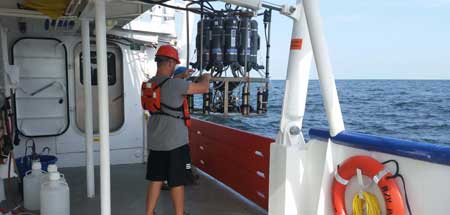Average ‘Dead Zone’ for Gulf of Mexico Predicted

Scientists forecast that this year’s Gulf of Mexico dead zone – an area of low to no oxygen that can kill fish and marine life – will be approximately 5,898 square miles or about the size of Connecticut, the same range as it has averaged over the last several years.
The dead zone in the Gulf of Mexico affects nationally important commercial and recreational fisheries. Hypoxic zones or “dead zones” are caused by high levels of nutrients, primarily from activities such as industrialized agriculture and inadequate wastewater treatment.
Hypoxia Cruise Hypoxia Water Samplings - 06082016 - LUMCON
The low oxygen levels cannot support most marine life and habitats in near-bottom waters. Organisms that can flee the dead zones leave the area, while others which cannot leave are stressed or die of suffocation. Reducing nutrients flowing to the Gulf would help the situation since, under normal conditions, this area contains a diversity of marine life, critical habitats, and a number of key fisheries.
“Dead zones are a real threat to Gulf fisheries and the communities that rely on them,” said Russell Callender, Ph.D., assistant NOAA administrator for the National Ocean Service. “We’ll continue to work with our partners to advance the science to reduce that threat. One way we’re doing that is by using new tools and resources, like better predictive models, to provide better information to communities and businesses.”
The NOAA-sponsored Gulf of Mexico hypoxia forecast is improving due to advancements of individual models and an increase in the number of models used for the forecast. Forecasts based on multiple models are called ensemble forecasts and are commonly used in hurricane and other weather forecasts.
This year marks the second year that a four-model forecast has been used. The four individual model predictions ranged from 5,204 to 6,823 square miles, and had a collective predictive interval of 3,200 to 8,597 square miles. The forecast assumes typical weather conditions, and the actual dead zone could be disrupted by hurricanes or tropical storms. Data from these four models are used to determine and meet the nutrient reduction targets set by the interagency Mississippi River/Gulf of Mexico Watershed Nutrient Task Force.
The hypoxia forecast is part of a larger NOAA effort to deliver ecological forecasts that support human health and well-being, coastal economies, and coastal and marine stewardship.
The Gulf of Mexico hypoxia forecast is based on nutrient runoff and river and stream data from USGS. USGS estimates that 146,000 metric tons of nitrate and 20,800 metric tons of phosphorus flowed down the Mississippi and Atchafalaya rivers into the Gulf of Mexico in May 2016. This is about 12 percent above the long-term (1980-2015) average for nitrogen, and 25 percent above the long-term average for phosphorus.
USGS operates more than 2,700 real-time stream gauges, 60 real-time nitrate sensors, and collects water quality data at long-term stations throughout the Mississippi River basin to track how nutrient loads are changing over time.
“By expanding the real-time nitrate monitoring network with partners throughout the basin, USGS is improving our understanding of where, when, and how much nitrate is pulsing out of small streams and large rivers and ultimately emptying to the Gulf of Mexico,” said Sarah J. Ryker, Ph.D., acting deputy assistant secretary for water and science at the Department of the Interior. “The forecast puts these data to additional use by showing how nutrient loading fuels the hypoxic zone size.”
The confirmed size of the 2016 Gulf dead zone will be released in early August, following a monitoring survey from July 24 to August 1, conducted on a NOAA vessel and funded through a partnership between NOAA, Northern Gulf Institute, and the Louisiana Universities Marine Consortium.

